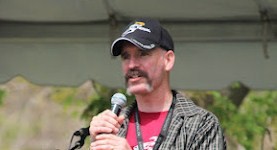GUERRILLA OUTREACH
Maria Nndem / John Cassells
“Standing before me, both of us sobbing, Christina unfolded her story. She showed me her back. It was raw and bloody. She had been whipped with a dismantled wire hanger. Apparently that’s what happens when you don’t bring in enough cash. Christina was forced into prostitution by her own father. She was ten years old.”
When I first heard this story, I wanted to believe it was fiction or, at least, in a faraway place. My friend, Maria, was the one telling it. I assumed she was telling me about a short term mission trip, and had some distance from this hell she had left behind.
19 year old Maria, in fact, was on something of a mission. With no youth work experience, she, alone, blocked off three days to discover who Calgary’s street kinds were, and where they could be found. Yes, Calgary! 10 year old Christina, was a Canadian girl!
Maria explains how she met Christina. “A street kid named ‘Stretch’ took me to an abandoned building. I found myself crawling through a broken basement window and being led through a series of hallways and doors. Finally, we reached the secret room. I gasped. There in front of me was a room stocked full of homeless people. They were shockingly young, and there were so many of them!
”Risky? For sure. Crazy? Maybe. But let’s look deeper. In her persistence, Maria, who knew nothing of the streets, had discovered that lost kids were holed up in that abandoned building. It was something that the local professionals needed to know, but somehow alluded them. Why was it that Maria could find these kids? Was it her willingness? Commitment? Freedom?
Knowing that there were street kids in her city that were not being reached, was not something that Maria could let go of. That experience birthed in her a passion and purpose. In the next two decades Maria would lead mobile outreach teams on the streets of Calgary, and change how that city’s hidden street youth were reached and cared for. Of course, she learned to work more responsibly, but not at the expense of effectiveness. It’s an outreach style that I affectionately call ‘guerrilla outreach’, and Maria is one of the best.
Mostly things are done in a more conservative fashion. Mitigating risk is number one. I’m all for that, but our concern for safety and wellbeing must also extend to those who are more vulnerable than ourselves. ‘Best Practices’ , while helpful, can, and often do, prevent us from giving our ‘best’ for those who need it most. Maria concedes that it’s easier, and safer, to “stay within the walls of an office.” It’s just that she never could.
When are you at your best? For me, it might have been the day I cooked breakfast for a half dozen kids. Yeah, I know; simple! Lots of people do that every day!
I had a full kitchen at my office, and would have preferred to have the kids meet me there. That wasn’t going to happen. I knew this particular group struggled with addictions and was not eating well, or often. It didn’t matter that they didn’t have bus fare, simply walking to the bus stop would have been a feat for the ones who were extremely emaciated and weak. If I was going to serve breakfast to this group, I’d have to jimmy open the back door of the building and bang on #306, while balancing a box of groceries. So that was it. You can image that the college practicum students I brought with me on such excursions learned a lot!
Apartment 306 was a flop house. Most of the kids I met there were homeless; staying a few days, at best. On that particular day there was a couple of new ones. A young man and a teenage girl. One of the kids remarked that he had forgotten how good bacon and eggs taste. As we sat around the table and talked, something changed. They began to look at me with new eyes. I stopped being their ‘worker’, and became a friend and guardian. There was a new level of trust that came from meeting them in their place of need. That day serves as a milestone for these young lives, who have gone on to experience restoration and success!
Guerrilla outreach involves a constant watch for new activities of street youth. I have often put together ‘scouting teams’ specific to that purpose. Even more importantly, guerrilla outreach maintains relationships with street youth who are ‘off the radar’. Such tactics will connect you with the most damaged and hard to reach young people. In my experience, it’s with this group that I’ve seen the greatest rates of recovery and reintegration, which underscores the importance of intentionality, on the part of the worker.
Never would I encourage outreach workers -staff or volunteers, to deviate from the appropriate protocols. At the same time, it’s never appropriate when kids like Christina cease to be the priority.
Maria Nndem works with Calgary Youth Unlimited (YFC) in the role of People and Program Development Director. Her focus is on developing young leaders who have the same heart for lost kids.


